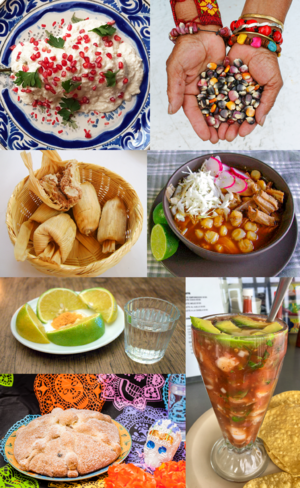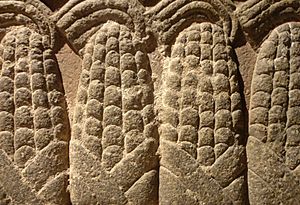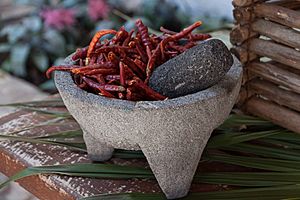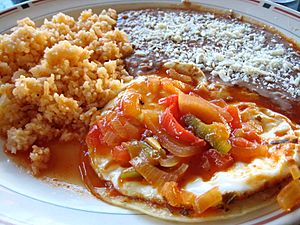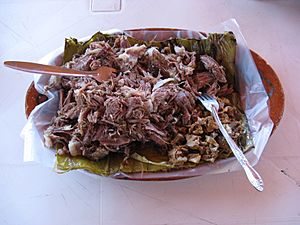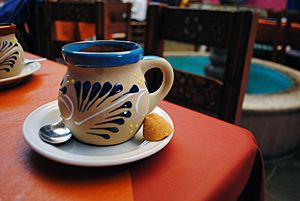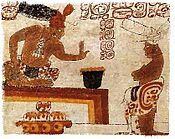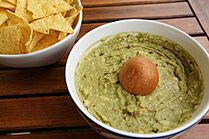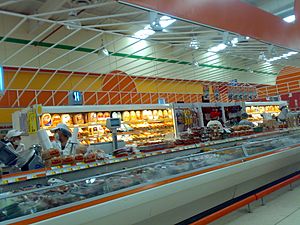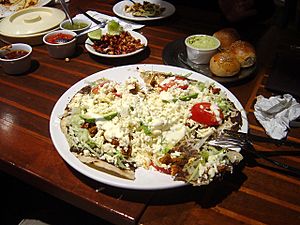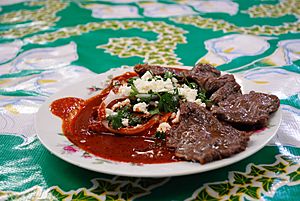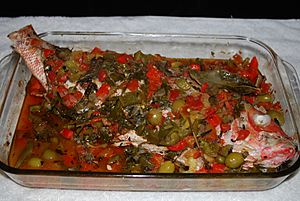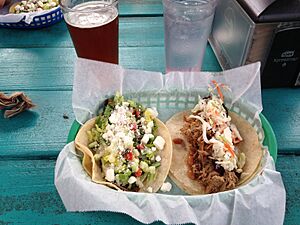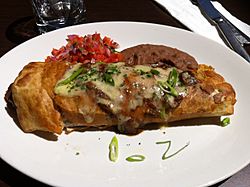Mexican cuisine facts for kids
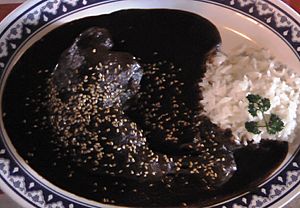
Mexican cuisine is the delicious food and cooking traditions of modern Mexico. Its oldest roots come from Mesoamerican cuisine. This means it started with early farming groups like the Olmec and Maya. They were the first to grow maize (corn) and create the special process called nixtamalization. This process helps make corn easier to grind and more nutritious.
Over time, other groups in Mesoamerica added their own cooking styles. These included the Teotihuacanos, Toltec, Huastec, and Aztec. When the Spanish arrived, they brought new foods. These included meats like beef, pork, and chicken. They also brought dairy products, rice, sugar, and olive oil. Spanish cooking styles and recipes also became part of Mexican food.
Later, African influences were added. This happened because of African slavery in New Spain. Today, Mexican cuisine is a very important part of Mexico's culture. It is used in social events and traditions. For example, mole is often eaten on special holidays. Because of its rich history and cultural importance, UNESCO recognized traditional Mexican cuisine in 2010. It is now on the Representative List of the Intangible Cultural Heritage of Humanity.
Contents
Basic Elements of Mexican Food
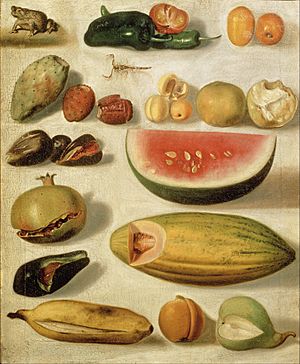

Mexican cuisine is very old and complex. Its cooking methods have been developed over thousands of years. It uses many ingredients that are native to Mexico. It also uses foods brought by the Spanish conquistadors.
Besides corn and chili peppers, native ingredients include squashes, avocados, cocoa, and vanilla. Some ingredients are not common in other foods. These include edible flowers and vegetables like huauzontle and papaloquelite. Small criollo avocados, which have edible skin, are also used. Chocolate started in Mexico and was highly valued by the Aztecs. It is still a key ingredient in Mexican cooking.
Vegetables are very important in Mexican food. Common ones are zucchini, cauliflower, corn, potatoes, and spinach. You will also find Swiss chard, mushrooms, red tomatoes (jitomate), and green tomatoes. Other traditional vegetables include chili pepper, huitlacoche (corn fungus), huauzontle, and nopal (cactus pads).
European foods brought to Mexico include pork, chicken, beef, cheese, herbs, and spices. Many fruits also came from Europe.
Tropical fruits are very popular, especially in central and southern Mexico. Many of these are native to the Americas. Examples include guava, prickly pear, sapote, mangoes, bananas, pineapple, and cherimoya (custard apple).
Eating insects, called entomophagy, has been a tradition in Mexico for thousands of years. Today, it is becoming more popular. People enjoy insects for their unique flavors and for being a sustainable food source. Popular insects include chapulines (grasshoppers or crickets), escamoles (ant larvae), and cumiles (stink bugs).
Maize: The Heart of Mexican Food
Even though wheat and rice came to Mexico, maize (corn) is still the most eaten grain. It is the main ingredient in many dishes. These include corn tortillas, atole, pozole, and tamales. Most corn is dried, then treated in a process called nixtamalization. This makes a dough called masa.
This masa is used fresh or fermented to make many dishes. It can be used for drinks like atole and pozole. It also makes tamales, sopes, and more. The most common way to eat corn in Mexico is as a tortilla. Tortillas are served with almost every meal. While most tortillas are made from corn, some regions use wheat or other plants.
Chile Peppers: Adding Flavor and Spice
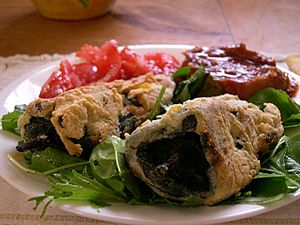
The chile pepper is another key ingredient in all parts of Mexico. Mexican food is known for being spicy, but it has many different flavors. Chiles are used for their taste, not just their heat. Mexico uses the widest variety of chiles in the world. If a savory dish does not have chile, hot sauce is usually added. Chiles are even added to fresh fruit and sweets.
Chiles have been important since the Mesoamerican period. They were as vital as corn and beans. In the 16th century, Bartolomé de las Casas wrote that native people felt they weren't eating without chiles. Even today, many Mexicans believe chiles are a big part of their national identity. They use chiles to create many kinds of sauces and salsas.
Many Mexican dishes are known by their sauces and the chiles they contain. These sauces are often very spicy. Examples include entomatada (in tomato sauce), adobo, and moles. A corn soup called pozole can be white, green, or red, depending on the chile sauce used. Tamales are different based on their filling, which is often a red or green chile sauce. Dishes without a sauce are usually eaten with salsa or fresh chiles. This includes street foods like tacos, tortas, and sopes. The type of chile used gives each dish its main flavor. Chipotle, a smoked-dried jalapeño pepper, is very common.
Beans: A Perfect Pair with Corn
Common beans (Phaseolus vulgaris) have always been a part of the Mexican diet, along with corn. Beans and corn are missing different important nutrients. But when eaten together, they provide all the necessary proteins. Popular bean types in Mexican cooking include pinto beans and black turtle beans.
Spanish Contributions to Mexican Cuisine
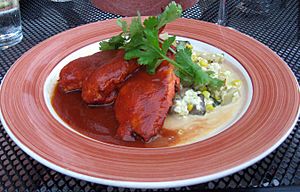
Spain greatly influenced Mexican cuisine in two main ways. First, the Spanish brought new foods that did not exist in the Americas. These included sugar, wheat, rice, onions, garlic, limes, and oil. They also introduced dairy products, pork, beef, and many other foods.
Second, they brought cooking traditions from Spain. These traditions became very common in Mexico. Spanish cuisine itself was influenced by its Moorish heritage. This created one of the world's first great fusion cuisines. The Spanish also taught the technique of frying food in pork fat. Today, the main meats in Mexico are pork, chicken, beef, goat, and sheep. Seafood and fish are also popular, especially along the coasts.
Cheesemaking in Mexico has developed its own special kinds of cheese. Spanish-style cheeses like Manchego are also made there. Making cheese is an important business, especially in northern Mexico. The main cheese-making areas are Chihuahua, Oaxaca, Querétaro, and Chiapas.
Churros are a common snack that came from Spain. Since sugar cane was brought to the Americas by the Spanish, all Mexican sweets have Spanish origins. Many of these sweets, like Alfeñiques, also have a Muslim heritage from Spain.
Food and Society in Mexico
Cooking at Home
In most of Mexico, especially in the countryside, people eat most of their meals at home. Cooking for the family is often seen as women's work. This includes cooking for celebrations. Traditionally, girls were considered ready to marry when they could cook well. Cooking is a main skill for housewives.
The main meal of the day in Mexico is called "comida," which means 'meal' in Spanish. It is usually eaten between noon and 2 PM and is the biggest meal. It might start with soup, often chicken broth with pasta. The main course is usually meat in a cooked sauce, with salsa on the side. It is served with beans and tortillas.
The first meal of the day is "desayuno," a light breakfast with coffee or a corn drink called atole. Some areas have "almuerzo" around 11 AM, which is a snack and a drink. The last meal is "cena," or dinner, eaten between 6 PM and 9 PM. Dinner often includes leftovers from the main meal or sweet bread with coffee or chocolate.
Food and Festivals: A Cultural Connection
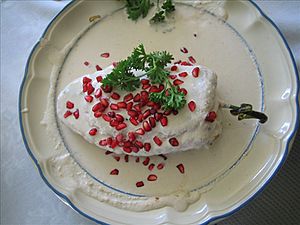
Mexican cuisine is very detailed and often linked to special meanings and festivals. This is why UNESCO recognized it as a World Heritage. Many Mexican foods are complex because they are connected to the country's social customs. Preparing food, especially for family and social events, is a way to keep social relationships strong. Even the idea of flavor is seen as social. Meals prepared for certain events are thought to taste the best.
The skill of cooking well, called "sazón," is seen as a special gift. It comes from experience and a dedication to those you are cooking for. For the Day of the Dead festival, foods like tamales and mole are placed on altars. People believe that visiting dead relatives eat the essence of the food. If living people eat it afterward, it is thought to be tasteless.
In central Mexico, popular festival foods include mole, barbacoa, carnitas, and mixiotes. These dishes are often made for hundreds of guests, needing many cooks. The cooking itself is a social custom that brings families and communities together.
Traditional Mexican home cooking is very different from the food in most Mexican restaurants outside Mexico. Those restaurants often serve a type of Tex-Mex food. The original versions of Mexican dishes are very different from their Tex-Mex versions.
Some traditional Mexican foods need complex or long cooking. This includes cooking underground, like cochinita pibil. Before machines, women spent hours boiling dried corn. Then they ground it on a metate to make dough for tortillas. They cooked each tortilla one by one on a comal griddle. In some areas, tortillas are still made this way. Sauces were also ground in a molcajete (mortar). Today, blenders are often used, but the texture is a bit different. Many Mexicans say molcajete-made sauces taste better, but few make them that way now.
The most important food for festivals is mole, especially mole poblano. Mole is served at Christmas, Easter, Day of the Dead, birthdays, weddings, and funerals. It is usually eaten only for special events because it is so complex to make. Other foods like barbacoa and carnitas have become acceptable for these events since the 1980s. This might be because they are cheaper or can be bought ready-made.
Another important festive food is the tamale. This is a filled cornmeal dumpling, steamed in a wrapping like a corn husk or banana leaf. It is a basic food in most parts of Mexico. Tamales started in the pre-Hispanic era and come in many varieties. Like mole, tamales are complex to prepare and are best made in large amounts. They are often eaten during celebrations like Candlemas.
Street Food: Quick and Tasty Bites

Mexican street food includes tacos, quesadillas, pambazos, and tamales. It also has foods that are hard to cook at home, like barbacoa and carnitas. Many Mexican homes do not have ovens, so roasted chicken is also a popular street food. One reason people love street food is to satisfy hunger without the social rules of eating at home.
Tacos are the most famous Mexican street food. They are made of meat or other fillings wrapped in a tortilla. Cheese is often added. Vegetarian fillings include mushrooms, potatoes, rice, or beans.
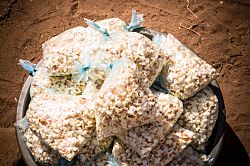
The taco's origin comes from the old custom of using tortillas to pick up other foods, as utensils were not used. The word "taco" might come from the Nahuatl word "tlaco," meaning middle or half. Tacos are usually eaten before midday or late in the evening, not as the main meal. Almost any food can be wrapped in a tortilla. This includes rice, meat, cream, vegetables, cheese, or just chile peppers and salsa. Favorite fillings change by region. Pork is common in central and southern Mexico, beef in the north, and seafood along the coasts. Chicken and lamb are popular everywhere.
Another popular street food, especially in Mexico City, is the torta. This is a roll filled with several ingredients. Tortas started in the 19th century when the French brought new kinds of bread. The first tortas were rolls split and filled with beans. Today, refried beans are still found on many tortas. In Mexico City, the common roll for tortas is called telera. In Puebla, the bread is called a cemita. Both are filled with various ingredients, often with beans, cream, and hot chile pepper.
American fast food has influenced Mexican street food since the late 20th century. An example is the Sonoran hot dog, created in the 1980s. These frankfurters are usually boiled, then wrapped in bacon and fried. They are served in a special bun. They are often topped with pinto beans, diced tomatoes, onions, jalapeño peppers, and other toppings.
Along the US-Mexican border, Mexican vendors sell food like fruit with Tajin spice. They use carts to sell to people crossing the border.
Besides food, street vendors also sell drinks. These include aguas frescas (flavored waters), tejuino, and tepache. They also sell treats like bionicos, tostilocos, and raspados (shaved ice). Most tamale stands sell atole as a common drink.
-
Tacos of carnitas, carne asada and al pastor.
-
Bean mini-gordita flavored with avocado leaf Veracruz-style
History of Mexican Cuisine
Ancient Times: Before the Spanish Arrived

Around 7000 BCE, native peoples in Mexico hunted animals and gathered plants. This included wild chili peppers. Corn was not yet grown, so a main food was roasted agave hearts. By 1200 BCE, corn was grown, and the nixtamalization process was developed. This made corn softer for grinding and improved its nutrition. This led to tortillas and other flatbreads. Native peoples have many stories about corn's origin, often saying it was a gift from gods like Quetzalcoatl.
Beans were another main food. They were eaten with corn and other plants to provide full protein. Other protein sources included amaranth, domesticated turkey, and insects like grasshoppers. They also ate iguanas and turtle eggs on the coasts. Vegetables included squash and its seeds, chilacayote, and jicama. Edible flowers, especially squash flowers, were also eaten. The chile pepper was used as food, in rituals, and as medicine.
When the Spanish arrived, the Aztecs had advanced farming methods and plenty of food. This was the base of their economy. It helped them expand their empire. They received tribute (payments) mostly in foods they could not grow themselves. According to Bernardino de Sahagún, the Nahua peoples of central Mexico ate corn, beans, turkey, fish, small animals, and insects. They also ate many fruits, vegetables, pulses, seeds, and tubers. They collected or grew wild mushrooms, plants, and herbs.
Modern Times: Spanish Influence and Beyond
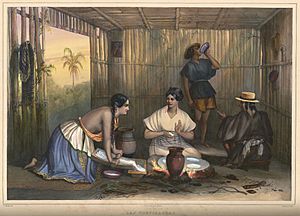
After the Spanish Conquest, the Spanish brought new foods and cooking methods, like frying. Regional foods stayed different. Native foods were more common in the rural south. Spanish foods became popular in the less populated north. European wheat bread was not liked at first. Moctezuma's messengers said it tasted like "dried maize stalks."
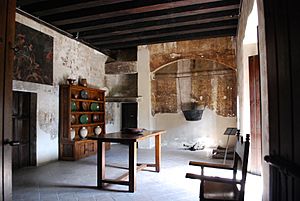
Spanish cuisine is a Mediterranean cuisine influenced by its Arab period. It uses staples like olive oil and rice. Spanish settlers brought these to Mexico. They also brought farm animals like pigs, cows, chickens, goats, and sheep. This increased the amount of meat and milk people ate. Cheese became the most important dairy product.
The Spanish brought rice and sugar cane to Mexico. Sugar cane was used to make many sweets, especially local fruits in syrup. A sugar candy craft called alfeñique was imported. It is now used for the Day of the Dead. Over time, ingredients like olive oil, rice, onions, garlic, oregano, coriander, cinnamon, and cloves mixed with native ingredients. Convents were key places where these two cuisines blended.
Despite Spanish influence, Mexican cuisine kept its base of corn, beans, and chili peppers. Native people still relied on corn. It was cheaper than wheat and easier to grow. European control over land grew with wheat farms. In 18th century Mexico City, wheat was baked into rolls called pan francés.
Pozole is mentioned in the 16th century Florentine Codex.
In the 18th century, an Italian friar named Ilarione da Bergamo wrote about food in his travel book. He noted that tortillas were eaten by both poor and rich people. He described lunch as pork products like chorizo and ham eaten with tortillas and spicy red chili sauce. For drinks, people had pulque or corn-based atole. Rich people also drank chocolate-based drinks twice a day.

During the 19th century, many immigrants came to Mexico. These included French, Lebanese, German, and Chinese. They all influenced the food. During the French intervention, French food became popular with the wealthy. One lasting influence is the variety of breads and sweet breads in Mexican bakeries, like bolillos and conchas.
Since the 20th century, food influences have gone back and forth between Mexico and the United States. Mexican cooking was still practiced in the Southwest United States after the Mexican–American War. But Diana Kennedy showed the difference between Mexican food and Tex-Mex.
Tex-Mex food developed from Mexican and Anglo influences in Texas in the late 19th century. It continues to grow. For example, flour tortillas became popular in the US only in the late 20th century. From north to south, much of the influence has been from food industrialization. Also, more food became available after the Mexican Revolution. Another clear sign of US influence is the rise of fast foods like hamburgers, hot dogs, and pizza.
In the late 20th century, international influences led to interest in haute cuisine (fancy cooking). Many professional chefs in Mexico are trained in French or international cooking. But they still prefer using Mexican ingredients and flavors. It is common to see quesadillas or small tacos among appetizers at fancy dinner parties in Mexico.
Professional cooking in Mexico is growing. It focuses on traditional methods and ingredients. In cities, people are interested in writing down and saving authentic Mexican food. This movement started in 1982 with the Mexican Culinary Circle of Mexico City. It was created by women chefs and food experts. They worried that traditions would be lost as foreign cooking became more popular. In 2010, UNESCO recognized Mexico's cuisine as a World Heritage.
Today, many world cuisines are popular in Mexico, leading to Mexican fusion. For example, sushi in Mexico often uses sauces made from mango and tamarind. It is often served with serrano-chili soy sauce.
Delicious Mexican Drinks
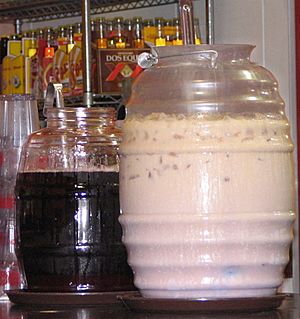
Corn in Mexico is not just eaten, but also drunk. Corn is the base of a hot drink called atole. It is flavored with fruit, chocolate, or rice. Fermented corn is used for cold drinks like tejuino and pozol. Aguas frescas are flavored drinks made from fruit, water, and sugar. Other drinks include hibiscus iced tea, tamarind drink, and a rice drink called horchata. A type of coffee called café de olla is brewed with cinnamon and raw sugar. Many popular drinks are sold by street vendors and juice bars.

Chocolate was very important in Mexican cuisine history. The word "chocolate" came from Mexico's Aztec cuisine. It comes from the Nahuatl word xocolatl. Chocolate was first drunk, not eaten. It was also used in religious rituals. The Maya civilization grew cacao trees. They used the cacao seeds to make a frothy, bitter drink. This drink, called xocoatl, was often flavored with vanilla, chile pepper, and achiote. Tejate is another Mexican drink made from cacao.
Alcoholic drinks from Mexico include tequila, pulque, aguardiente, and mezcal. Wine, rum, and beer are also made. The most common alcoholic drink with food in Mexico is beer, then tequila. A classic margarita is made with tequila, cointreau, and lime juice.
Rompope is believed to have been first made in the convents of Puebla, Mexico. The word rompope comes from rompon, the Spanish version of eggnog that came to Mexico.
A popular soft drink from Mexico is Sangria Señorial. It is a non-alcoholic drink with a sangria flavor. Sangria is a Spanish drink that was brought by Spaniards, just like Horchata and Agua de Jamaica.
Regional Mexican Cuisines
Chiapas: Unique Herbs and Flavors
Like other parts of Mexico, corn is a main food in Chiapas. Many native foods are still strong in the cuisine. A chile called simojovel is used only here. The food also stands out because it uses herbs like chipilín and hierba santa. Like in Oaxaca, tamales are often wrapped in banana leaves. Chipilín is often mixed into the dough. Boiled corn is drunk as a beverage called pozol, often flavored with natural cacao. Another drink from this region is Tascalate. It is made from powdered corn, cocoa beans, achiote, chilies, pine nuts, and cinnamon.
The favorite meats are beef, pork, and chicken, brought by the Spanish. This is especially true in the highlands, where livestock are raised. The livestock industry also led to cheesemaking. Cheeses are mostly made on ranches and in small groups. The best-known cheeses are from Ocosingo, Rayón, and Pijijiapan. Meat and cheese dishes often come with vegetables like squash, chayote, and carrots.
Mexico City: A Mix of Flavors
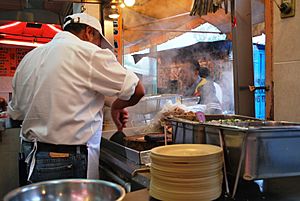
The food in Mexico City is special because it has been influenced by all other regions of Mexico. It also has many foreign influences. This is because people from all over Mexico have moved to Mexico City for a long time. Most ingredients for this area's cooking are not grown locally. They are brought in from all over the country, like tropical fruits.
Street food is very popular. You can find taco stands and lunch counters everywhere. Popular foods include barbacoa (from the central highlands) and birria (from western Mexico). Also popular are cabrito (from the north) and carnitas (from Michoacán). Mole sauces (from Puebla) are also common. Tacos have many different fillings. Large sub-like sandwiches called tortas are usually sold at special shops. Mexico City also has most of Mexico's haute cuisine (fancy restaurants). Some places even specialize in pre-Hispanic food, including dishes with insects.
Northern Mexico: Meat and Wheat
The foods in northern Mexico have been different from the south since ancient times. Here, native people hunted and gathered food. They had limited farming because of the dry land.
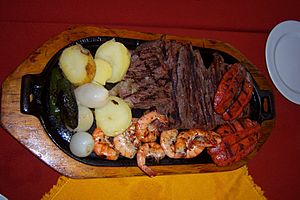
When Europeans arrived, they found much of the land good for raising cattle, goats, and sheep. This led to meat, especially beef, being very important in the region. Some popular dishes include machaca, arrachera, and cabrito. The special cooking method here is grilling. Ranch culture led to men cooking outdoors.
Ranch culture also led to cheese production. The north makes the most types of cheese in Mexico. These include queso fresco (fresh farmer's cheese) and ranchero. Also, Chihuahua's creamy queso menonita, and many types of asadero (smoked cheese).
Another important part of northern cooking is wheat, especially in flour tortillas. The area has at least forty different types of flour tortillas. This is because much of the land supports wheat farming, brought by the Spanish. These large tortillas led to the creation of burritos in Ciudad Juárez. Burritos later became popular in the Southwest United States.
The variety of foods in the north is not as wide as in the south. This is because of the mostly desert climate. Much of the food here depends on food preservation methods like drying and canning. Dried foods include meat, chiles, squash, and beans. Many of these are also canned. Preservation changes the flavor of foods. For example, many chiles are less hot after drying.
In Northeastern Mexico, during Spanish rule, Nuevo León was settled by Spanish families of Jewish origin. They added dishes like pan de semita (bread without leavening) and cabrito (baby goat). Cabrito is the typical food of Monterrey and Nuevo León.
The north has also seen immigrants from China, Mormons, and Mennonites. They have influenced foods in areas like Chihuahua and Baja California. Recently, Baja Med cuisine has appeared in Ensenada. It mixes Mexican and Mediterranean flavors.
Oaxaca: Land of Seven Moles
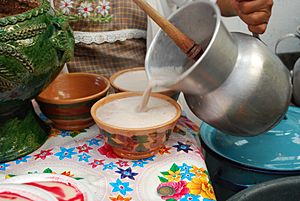
The cooking of Oaxaca stayed more traditional after the Spanish conquest. The Spanish took the area with less fighting, so the economy and food production were not disrupted as much. However, it was the first area to mix foods and cooking styles. Central Mexico was still recovering at that time. Despite its size, Oaxaca has many different environments and native foods. Vegetables grow in the central valley, seafood is plentiful on the coast, and tropical fruits grow near Veracruz.
Much of the state's cooking is influenced by the Mixtec and Zapotec. Later, Oaxaca became less important as a food supplier. Its cooking returned to a more native style, keeping only a few Spanish foods like chicken and pork. It also adapted mozzarella from the Spanish, creating what is now Oaxaca cheese.
A main feature of Oaxacan cuisine is its seven mole varieties. They are second in popularity only to mole poblano. The seven are Negro (black), Amarillo (yellow), Coloradito (little red), Mancha Manteles (tablecloth stainer), Chichilo (smoky stew), Rojo (red), and Verde (green).
Corn is the main food. Tortillas are called blandas and are part of every meal. Corn is also used to make empanadas and tamales. Black beans are favored, often served in soup or as a sauce for enfrijoladas. Oaxaca's regional chile peppers include pasilla oaxaqueña (red, hot, and smoky). These, along with herbs like hoja santa, give the food its unique taste.
Another important part of Oaxacan cuisine is chocolate, usually drunk as a beverage. It is often ground by hand and mixed with almonds, cinnamon, and other ingredients.
Veracruz: A Blend of Cultures
The food of Veracruz is a mix of native, Afro-Mexican, and Spanish influences. The native part comes from using corn as a staple. Also, vanilla (native to the state) and herbs like acuyo and hoja santa are used. It also has many tropical fruits like papaya and pineapple, brought by the Spanish. The Spanish also brought European herbs like parsley, thyme, and cilantro. These herbs are key to many dishes, including the famous Huachinango a la veracruzana, a red snapper dish.
The African influence comes from slaves brought through the Caribbean. They brought foods that had been introduced to Africa by the Portuguese. Since Veracruz is on the Gulf coast, seafood is very important. The state's role as a gateway to Mexico means corn is less common than in other parts of Mexico. Rice is a strong favorite. Corn dishes include garnachas (a type of corn cake), especially in the mountain areas where native influence is strongest.
Western Mexico: Fish, Pork, and Tequila
West of Mexico City are the Pacific coast states of Michoacán, Jalisco, and Colima. Michoacán's food is based on the Purepecha culture. The area has many rivers and lakes with fish. Its use of corn is perhaps the most varied. While atole is drunk in most of Mexico, it has more flavors in Michoacán, like blackberry. Tamales come in different shapes, wrapped in corn husks. These include those folded into shapes called corundas. In the Bajío area, tamales are often served with a meat stew called churipo.
The main Spanish contributions to Michoacán food are rice, pork, and spices. One famous dish is morisquesta, a sausage and rice dish. Another is carnitas, which is deep-fried pork. Carnitas can be found in many parts of Mexico, often said to be truly from Michoacán. Other important ingredients include wheat, found in breads and pastries. Sugar is also important, leading to many desserts and sweets like fruit jellies and ice cream. The town of Cotija has a cheese named after it. The local alcoholic drink is charanda, made from fermented sugar cane.
The food of Jalisco and Colima is known for dishes like birria, chilayo, menudo, and pork dishes. Jalisco is famous for tequila. Tequila can only be made in certain areas to use the name. The main food center of the area is Guadalajara. The best-known dish is birria, a stew of goat, beef, or pork with chiles and spices.
An important street food is tortas ahogadas, where the sandwich is "drowned" in a chile sauce. Near Guadalajara is Tonalá, known for its pozole, a corn stew. A popular local drink is tejuino, made from fermented corn. Bionico is also a popular dessert.
On the Pacific coast, seafood is common. It is usually cooked with European spices and chile, and served with spicy salsa. Popular fish include marlin, swordfish, and snapper. Tropical fruits are also important. The food of the Baja California Peninsula has a lot of seafood. It also uses a mild green chile pepper and dates, especially in sweets.
-
Tamales wrapped in corn husks.
-
Mojarra frita (fried) served with various garnishes, including nopales, at Isla de Janitzio, Michoacán.
-
Birria, a common dish in Guadalajara.
-
Asado de boda (Wedding stew), typical dish of Zacatecas.
-
Torta ahogada accompanied by light beer, Jalisco.
Yucatán: Maya Flavors with a Twist

The food of the Yucatán peninsula is different from the rest of Mexico. It is mostly based on Maya food. It also has influences from the Caribbean, Central Mexican, European, and Middle Eastern cultures. Like other areas, corn is the basic food, both liquid and solid. A common way to eat corn, especially for the poor, is a thin drink called pozol.
One main spice is the annatto seed, called achiote. It gives food a reddish color and a slightly peppery smell. Recados are seasoning pastes, often made with achiote (recado rojo). They are used on chicken and pork.
Recado rojo is used for the area's most famous dish, cochinita pibil. Pibil means a cooking method where foods are wrapped, usually in banana leaves. Then they are cooked in a pit oven. Different meats are cooked this way. Habaneros are another special ingredient. They are usually served on the side as condiments, not mixed into the dishes.
A key part of Yucatán cooking is using bitter oranges. They give Yucatán food its tangy flavor. Bitter orange is used to season broth and marinate meat. Its juice, mixed with sugar, is a refreshing drink.
Honey was used long before the Spanish arrived to sweeten foods. It was also used to make a ritual alcoholic drink called balché. Today, a honey liquor called xtabentun is still made and drunk. Coastal areas have many seafood dishes. They use fish like Mero and Esmedregal. These are fried and served with a spicy salsa. Other dishes include conch fillet and coconut-flavored shrimp.
Traditionally, some dishes are served as main courses. These include brazo de reina (a tamale made from chaya) and papadzules (egg tacos in a pumpkin seed gravy).
Street food often includes Cochinita Pibil Tacos and Lebanese-based kibbeh. Also popular are shawarma tacos, corn dough snacks called piedras, and fruit-flavored ices.
Lime soup is made of chicken or other meat, lime juice, and served with tortilla chips. Panucho is a refried tortilla stuffed with black beans. It is topped with chopped cabbage, pulled chicken or turkey, tomato, pickled red onion, avocado, and pickled jalapeño pepper.
-
Cochinita Pibil, a fire pit-smoked pork dish, seasoned with achiote, spices and Seville orange.
-
Frijol con puerco (beans with pork) prepared with beans, pork, epazote, onion, cilantro, lemon, radishes and habanero chile.
Sweet Treats: Mexican Desserts
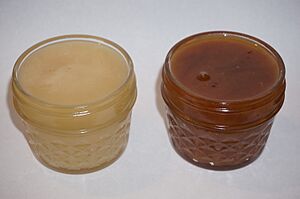
Desserts in Mexico did not really develop until the Spanish arrived. Before that, foods like chocolate were eaten, but in different ways. With Europeans, sugar came to the region, and with it, sweets. The range of desserts grew over time. It now includes everything from churros to rice pudding, and from cakes to fruit treats. Some traditional Mexican desserts are easy to make in large amounts.
Chocolate: From Drink to Treat
Before Europeans, chocolate was drunk as a warm, syrupy drink mixed with honey. It was also used as medicine. After Europeans arrived, chocolate was brought to Europe. There, it was used in medicines and candies. Today, chocolate is used as a topping, a dip, and in candies. The old way of drinking chocolate lives on in Mexican hot chocolate, which is a natural evolution of the warm syrup.
Fruity Delights
Many fruit-based dessert recipes are popular in Mexico. Some use native fruits like plantains, and others use foreign fruits like oranges. Recipes for these foods date back to the early 19th century. They use both sugar and ice. Fruit dishes are naturally sweet and juicy, which made them popular in Mexico's climate.
One such dessert is orange and lime ice. It is like a snow cone. It is made by freezing strained orange and lime juice mixed with sugar.
Baked Goodies
Baked desserts in Mexico mostly came from Europe over time. These items came from different countries before becoming common desserts. Baked goods include cookies made with local fruits, churros (from Spain), and macaroons (from Italy). Churros are made by mixing flour with boiling water, shaping and frying it. Then they are coated in cinnamon and/or sugar. Churros can be eaten hot or cold and shaped in many ways.
Mexican Food Around the World
Mexican cuisine is served in some nice restaurants in Europe and the United States. Sometimes, special corn from Mexico is brought in and ground right there.
Mexican Food in the United States
Mexican food in the United States is based on the food of Native Americans and Hispanic people in the Southwestern United States and Northern Mexico. Mexican foods that started in the US often come from the Southwest. For example, breakfast burritos and red or green chile come from New Mexican cuisine. Also, chili con carne and chimichangas are examples of Tex-Mex. As more Mexican-American people live in the US, more authentic Mexican food is appearing. Most large American cities have Mexican restaurants and food trucks. This is because Mexican immigrants use food to feel less homesick. For their children, it is a symbol of their heritage. Also, more Americans are trying Mexican food in Mexico, so they want more authentic flavors. Korean tacos are a mix of Korean and Mexican food. They are popular in cities in the US and Canada. In 2013, Carlos Gaytán was the first Mexican chef to get a Michelin star for his restaurant in Chicago.
|
See also
 In Spanish: Gastronomía de México para niños
In Spanish: Gastronomía de México para niños
- Tex-Mex
- Aztec cuisine
- Diana Kennedy
- Latin American cuisine
- List of Mexican dishes
- List of restaurants in Mexico
- List of Mexican restaurants
- Moctezuma's Table
- Alejandro Ruiz Olmedo
- Enrique Olvera
- Gabriela Cámara
- Carmen Ramírez Degollado
- Ancient Maya cuisine
- Mexican cuisine in the United States
- Indigenous cuisine of the Americas
- Spanish cuisine
- Cuisine of California
- Texan cuisine
- New Mexican cuisine
- Mexican tea culture
- Korean-Mexican fusion


